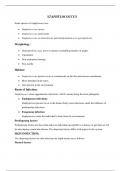Class notes
A guide to Medical Microbiology: Your Essential Handbook for Acing Basic Exams
- Course
- Institution
- Book
Imagine a comprehensive document meticulously covering the majority of known microbes, detailing their characteristics, behaviors, and roles in health and disease. Such a resource serves as a vital tool for anyone passionate about understanding the intricate world of microbiology. Whether you're a ...
[Show more]



